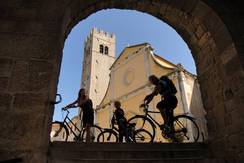Located in the north-eastern part of the Adriatic Sea, Istria is a peninsula surrounded by the sea on three sides. Its very favourable geographical location places it at the heart of Europe, halfway between the Equator and the North Pole, which is why Istria has always been a bridge between the Central-European continent and the Mediterranean.
Surface:
The total surface of the Istrian peninsula is 3,476 square kilometres, divided among three states: Croatia, Slovenia and Italy. The largest part, specifically 3.130 square kilometres (90% of the surface), belongs to the Republic of Croatia. The most of that is part of Istrian County: 2.820 square kilometres or 4,98% of the total surface of the Republic of Croatia. The remaining territory of Istria is under the administrative competence of Primorsko-goranska County.
Relief:
According to its geological and geomorphologic structure, the Istrian peninsula can be divided into three completely different areas. The hilly northern and north-eastern rim of the peninsula, with its sparse vegetation and barren Karst terrain, is known as white Istria. To the south-west of White Istria there is a morphologically much more varied area, made up of flysch foothills with impermeable marl, clay and sandstone layers, giving it the name of Grey Istria. The limestone plateau running alongside the coast, covered with red earth, is called Red Istria.
Climate:
Istrian peninsula is characterized by Mediterranean climate along the coast, which in the hinterland, under the influence of cold air coming down from the mountains and owing to the proximity of the Alps, gradually changes into a more continental climate .
Vegetation:
One third of the Istrian peninsula is covered by forests, mostly pines and scrubland near the coast and on the islands, interrupted here and there by holly oaks and strawberry trees.
Istria boasts many natural attractions, one of the most interesting being the Brijuni archipelago, home to approximately 680 plant species and adorned by olive orchards. On Učka mountain and the Ćićarija plateau, upwards of 500 m above sea level, rise thick beech forests. Protected areas in Istria County include many natural reserves: the Brijuni National Park, the Učka Nature Park, the protected landscape of Lim Fjord, the Motovun Forest, the Zlatni rt forest park, the bird reserve Palud near Rovinj, the Šijana forest park near Pula and Kamenjak protected landscape in the southernmost part of Istria.
Water flows:
The presence of impermeable flysch layers has made Istria rich with water. The most significant surface waterways in Istrian County are Mirna, Raša, Boljunčica, Dragonja, and the sinking stream Pazinčica. In terms of water supply, an important role is played by surface reservoirs Butoniga and Boljunčica.
Mirna is the longest and water-richest Istrian river: 53 km long, it rises near Buzet and flows into the Adriatic Sea near Novigrad.
Coast:
The total length of the Istrian coast, including the islands and islets, is 539 kilometers. The western coast of Istria is longer and more indented, measuring 212 km, islets included.
Administrative division:
From an administrative point of view, Istrian County is divided into 41 territorial units of local self-government: 10 cities and 31 municipalities.
• The cities are: Buje-Buie, Buzet, Labin, Novigrad-Cittanova, Pazin, Poreč, Pula, Rovinj-Rovigno, Umag-Umago and Vodnjan.
• The municipalities are: Bale, Barban, Brtonigla-Verteneglio, Cerovlje, Fažana, Funtana, Gračišće, Grožnjan-Grisignana, Kanfanar, Karojba, Kaštelir - Labinci, Kršan, Lanišće, Ližnjan, Lupoglav, Marčana, Medulin, Motovun, Oprtalj-Portole, Pićan, Raša, Sveti Lovreč, Sveta Nedelja, Sveti Petar u šumi, Svetvinčenat, Tar-Vabriga, Tinjan, Višnjan, Vižinada, Vrsar and Žminj
The administrative seat of Istria is Pazin (9.227 inhabitants).
The economic centre is Pula (58.594 inhabitants).
Inhabitants and awerage population density:
According to the 2001 census, Istria had 206,344 inhabitants, making up 4.65 % of the population of the Republic of Croatia. The average population density is 73 inhabitants per km2.






